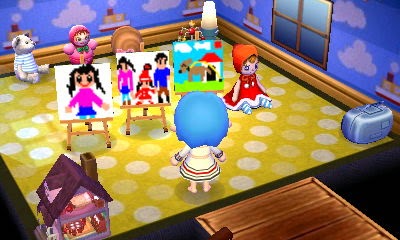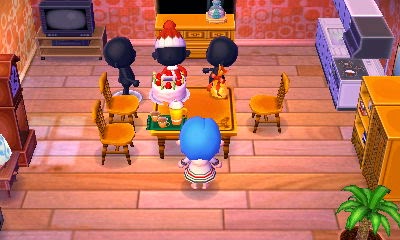Part 1 - Interior Design
Part 2 - Patterns and Designs
Part 3 - More about Patterns and Designs
Part 4 - Introduction to Town Decor
Part 5 - Pattern Design in Town Decor
Part 6 - Gardening in Town Decor
Part 7 - Aika Village
Part 8 - More on Aika Village
Onwards!
***
The second-to-last post about Aika . . .! Yeesh, you'd think I'd have enough of this, but nope! Still going! Still . . . going . . . *SNORE*
I really should've said no, looking back on it.
As I mentioned before, Aika Village is accessable via the Dream Suite in Animal Crossing: New Leaf. That's how you get to it in the same circumstances as everybody else, and to be honest, I think it's better to use it through the Dream Suite than if you had to visit it like you do other towns. This means that a lot of people can go see it, and because of it's popularity, it's dragged up a lot of theories.
That dog's howling no more . . .
Creepy pair of mittens, what?
First is about the graveyard. It's pretty obvious what's going on in the graveyard, of course - the child's dog was buried here . . . many times. Odd, yes, but I'm more concerned about the mittens. Did they belong to somebody, left behind after some sort of incident? Did that person jump to their deaths? Remember that in the last house, the mother and father - two of the mannequins in the first house - weren't there. Did one of them die near this spot? Who knows . . .
See, even in the upper right, the girl isn't even looking at us anymore. Yeesh, even she's scared at this point.
Creepy Gaming seemed to draw the connection between the parents and the potential deaths. As I mentioned before, Creepy Gaming explained the reference of the shoes on the beach as having to do with Japanese suicides, where one would leave their shoes on the beach before - well, yeah, dying. Not pleasant to think, and to make it worse, Creepy Gaming (from what I recall) seemed to suggest that the mother might've died this way while the father died in the creepy torture chamber from before. Y'know, this one?
Nope, I'm just taking a nap, not trapped in a nightmare at all, yo.
I thought you might remember.
While it's a good theory, I have some different suggestions. Considering how murderous and creepy this doll is, I would like to suggest that the doll set it up - the doll set up the shoes on the beach to make it look like the mother killed herself, only to torture her along with the husband down here. Of course, it'd be better supported with some more evidence (i.e. showing where the mannequin-parents disappeared to), but sadly, we get no such relief. So it goes.
I know what you did, you stupid dolly. I will never be able to look at Red Riding Hood the same way again.
Then we come to the story of this doll. From what I can garner, the theories about this doll pretty much line up - it's a sentient doll that seems to want the girl celebrating the birthday downstairs in the first house, the same girl who owns the houses. Why? Perhaps jealousy. Either way, the goal seems to be to take care of the problem by killing the parents, as well as whoever else finds out. Then again, the other dolls may or may not be helping, although there's little to go off of there.
Round one, fight?
Most theories probably come off of what's going on in this back room. Has the dolly taken the girl into an ultimate match to the death? As a captive? As her next torture victim? I believe that the girl is trapped there with the dolly, now the doll's alone, and if she tries to leave . . . well, the axe is a good enough warning, isn't it?
SO INSTEAD, LET'S LOOK AT IT FROM AN ARTISTIC POINT OF VIEW!!
Happy Birthday, Molly! Now it's time to die.
As I'm sure I mentioned in the second part, the interior design in this game sort of has to work off of a principle of minimalism, at least to a certain degree. After all, there's only so much furniture you can buy! But in the case here, I believe that the minimalism was used to a great degree. Not many people could pull off some of the style and use here, especially with some of the more complex rooms!
Props to the maze. I mean, metaphorical props.
This room is a really good example in terms of the minimalism required in the game. How do you make a maze without making it too obvious where to go? Dark pillows, small beacons of light, scattered stools that give you little in terms of direction . . . the execution of this room is probably one of my favorite aspects of the town, although that's my personal thought, just based on what the artist was going for and how they executed it. Hat's off to him/her!
To quote one of my own characters: "ENGLISH! Can! You! Speak! English?!"
Another artistic element relating to this town is the story behind it. Clearly, there is an element of story in this town - it's obvious from the get-go, the way it's set up. Even down to the details, we get good direction of what's going on even without text and speech, which is an incredible feat in a world of words.
I'm hiding from the dolly. Call back later.
Of course, one of my favorite aspects of Aika is the obvious symbolism used throughout the town, especially with the environment. The way it changes between houses is absolutely incredibly - it just goes to show how much thought was put into this, how hard this person must've worked to put it together. And there's so much going on, as well - from perfection to mazes to ruin to utter desolation, the symbolism helps tie together the mood and the story so well it's amazing.
I'm going to hope that my art is better than this kid's.
Lastly, I want to point out the progression of the doodles. The above picture is in the first house, where they're intact. These little doodles, done by the little girl, progress onwards as items representing obsession and are used to help tell the story from the perspective of the dolly. These images are both worshiped and reviled - used to decorate the surroundings and to show hatred, especially in the last house, where they're completely ruined and scraped away. They really help to set the tone for this town, including the doll's motives - which, of course, are what help string away this plot from the get-go.
But all of this is well and good, neverminding some of the obvious issues, such as the confusing rooms and the undeciphered Japanese. But there was a point to going to this town, of course - a very important point. And believe me, I haven't forgotten it - quite the opposite. That point:
Is this art?
There's just one more part to go, guys. I'm hoping to cover my thoughts on all of this once and for all then.





































































